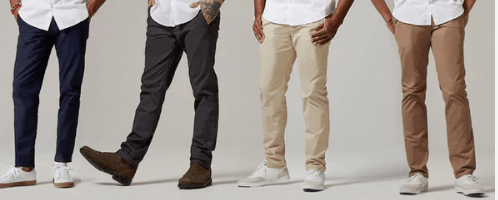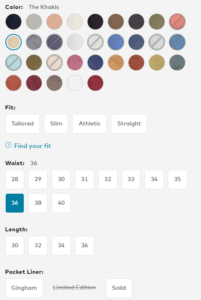What do a Pair of Pants and a Business have in Common? The Perfect FIT

Generally speaking, men don’t like to shop. So how did Bonobos, an all-male clothing line, grown to become the largest clothing brand ever built on the web? By tapping into the male shopping psyche and creating business and operating models to provide the best shopping experience possible.
Even though they are GSB alumni (2007), we must applaud Bonobos co-founders Andy Dunn and Brian Spaly for creating a business, online retailer Bonobos, which perfectly caters to the male shopper’s needs. Bonobos co-founders understand and capitalize on the male shopping psyche, which differs significantly from women (depicted below). Men value fit, style, and trends (numerator) and that value is eroded by time and hassle (denominator). In contrast, women value trends and style over fit and generally enjoy the shopping experience.
Modified from LSVP 2010.
The Bonobos value proposition is to be the “home of better-fitting menswear and an easier shopping experience [for men]” (bonobos.com). Dunn and Spaly designed an operating model founded on digital technology to deliver this value.
The Perfect Fit
From its conception, the purpose of Bonobos was to create a better fitting pair of pants for men – not too baggy, not too tight, just right. The secret was a new curved waist band that followed the natural contour of a man’s waist. The standard pants also have a trim line and medium rise that fit most men. However, the style is highly customizable, so Bonobos has the perfect fit for every shape and preference. Bonobos quickly expanded into other men’s apparel, including shirts, suits, swimwear, etc., all dedicated to the perfect fit. To give you a sense of the variety available to offer the perfect fit, Bonobos has over 3,000 SKUs (across fit, color and size) in washed chinos, as well as 280 pants, 230 casual shirts, and 200 dress shirt variations (Parr 2016).
(Bonobos 2016)
The Perfect Experience
Not only does Bonobos provide the perfect fitting pant, they provide it in the perfect shopping experience for men. Bonobos faced a challenge; on average, men only shop two times per year, compared to the average woman who shops once per month (Feloni 2015). However, Bonobos relied on digital technology to create an operating model, described below, that is quick and easy – perfect for men.
E-commerce…
When Bonobos launched in 2007 it was sold exclusively online and was the first “digitally native vertical brand” in the U.S. Considering that men like the easiest shopping experience possible, e-commerce was a no-brainer. Bonobos offered free shipping and hassle-free returns. Bonobos differentiated itself from traditional e-commerce because it was vertically integrated, controlling its own manufacturing and distribution.
…Turns Brick and Mortar
However, with the goal of increasing customer acquisition, building customer relationships, and ultimately increasing retention, Bonobos extended from e-commerce to brick and mortar. Bonobos became the first e-commerce site to create what co-founder Dunn hopes to be the “store of the future”: Guideshops (Parr 2016). Guideshops are brick and mortar stores where customers can be fitted for style and size, but the stores don’t have any inventory. Orders are placed online using a tablet app that seamlessly connects the guideshops to the e-commerce platform, and the clothes are shipped to the customer for free.
Customer Service: Guideshops are staffed with several “Ninjas,” customer service representatives/salesmen who create a pleasant shopping experience. They provide custom fitting, fashion advice, and BEER! Bonobos also offers premium customer service online and over the phone for those who don’t visit a guideshop.
No Inventory: It may seem strange to walk into a clothing store that doesn’t carry any inventory, but the idea is genius for men who don’t want to lug around shopping bags. Instead, after a customer makes his purchase decisions a Ninja will place the order on the online platform.
Furthermore, having no inventory helps reduce holding costs and allows Bonobos be flexible in changing products in response of customer feedback and demand. It also reduces labor costs associated with inventory restocking. Bonobos’ sales per square foot is one of the highest in the industry, at approximately 1,000 in retail sales per square foot, surpassed only by a few traditional brick and mortar stores, including Tiffany’s, Apple, and Lululemon (Lacy 2013).
Conclusion
Fast-forward eight years and Bonobos has become the largest clothing brand ever built on the web (Heroku 2016), has hit $100 Million in revenue (Parr 2016), and has recently become profitable (Feloni 2015). Bonobos has created a winning recipe by understanding that men want perfectly fitting clothes delivered in a convenient manner and creating an operating model to meet those needs.
To continue to grow and offer unique value, Bonobos should consider how they can make the shopping experience even easier by leveraging their online platform. For example, Bonobos could develop additional tools to make finding the perfect fit online even easier, with an interactive “fit” calculator. Bonobos could also provide interactive online fashion consulting, so men could receive outfit suggestions from the comfort of the couch.
Word Count: 777
Bonobos. 2016. Washed Chinos. https://bonobos.com/products/washed-chinos?color=the%20khakis&pant-fit=boot&pant-waist=36
Feloni, Richard. 2015. After 8 years and $128 million raised, the clock is ticking for men’s retailer Bonobos. Business Insider. http://www.businessinsider.com/how-bonobos-is-maturing-into-a-major-brand-2015-8
Heroku. 2016. Bonobos Migrates their Personalized E-Commerce Experience from AWS to Heroku. https://www.heroku.com/customers/bonobos
Lacy, Sarah. 2013. Nice pants: Bonobos raises $30m off of strong growth and Nordstrom deal. Pando Media Inc. https://pando.com/2013/03/13/nice-pants-bonobos-raises-30m-off-of-strong-growth-and-nordstrom-deal/
Lightspeed Venture Partners (LSVP). 2010. Why Lightspeed invested in Bonobos.
http://lsvp.com/2010/12/16/why-lightspeed-invested-in-bonobos/
Parr, Sam. 2016. How The Bonobos Founder Went from “Insufficient ATM Funds” to Over $100 Million in Revenue. The Hustle. http://thehustle.co/bonobos-andy-dunn





Hi Molly!
I perfectly fit (no pun intended) the customer type you described, and my utility function probably weighs convenience and not having to shop at as store even more when it comes to clothing. I am therefore a customer of many of these online clothing stores myself but I fully agree with you that there is something to be done around improving fit without having to try in a store, which would be a win-win for the customer and the company given the costs associated with returns. I also think that there has to be a way of assessing body type and fit through simple measurements as well as “scanning” of the body through a smartphone, kind of like QR codes. Maybe the technology isn’t quite there yet but it seems to me like this could be an opportunity in the future, to improve the currently digitized business model and make it even more convenient for shoppers.
Great article Molly! I only wish there was a similar concept for women who do not find shopping enjoyable and are also just looking for good fitting clothes (admittedly they are probably in the minority and not profitable to serve).
The thing that struck me the most was the fact Bonobos offered over 3,000 SKU’s across fit/color/size, which I could only imagine is a nightmare to manage. I was wondering if you had any insight into their inventory management practices. Do they maintain a minimum inventory quantity on hand of each SKU in their distribution center or produce more just in time (doubt it)? If its the former, isn’t it super expensive to keep that many SKUs stocked, and requires fantastic demand forecasting to ensure there are no stock outs?
Much to the point Sebastien made in the comment above, I would love to see Bonobos (or any retailer) invest in technology that would allowed us to see how the clothes they are selling look on our actual bodies. This could go a long way in making brick/mortar completely obsolete as well as reduce the number of returns.
Great article! I’m just curious about one question: is there any fundamental difference between Bonobos and other male apparel brand in terms of business model? I actually didn’t see much difference, except Bonobos only sells online. Yes online one-stop shopping for clothes / pants / everything for a whole season does save time for male consumers, but there’s still a good chance that the size / style / color of online products are different from your expectation and you still need to deal with returns and exchanges. That also takes time and would be even annoying. A lot of male consumers that I know would rather stick to several offline stores of their favorite brand and visit every 3 months. Also, many of the traditional male apparel brands also have their own online stores – also free shipping and free return. So what’s the key competitive edge of Bonobos?
Great article! It easy to see how Bonobos’ operating model has been able to deliver value to both customers and the retailer. I’m curious what your thoughts are regarding competition. Bonobos differentiates itself on the shopping experience more so than on its product. (It would be very easy for another retailer to buy a pair of Bonobos’ pants in order to study the fit and then produce on its own). Given the components of Bonobos’ operating model are easy to replicate how do you suggest they stave off competition?